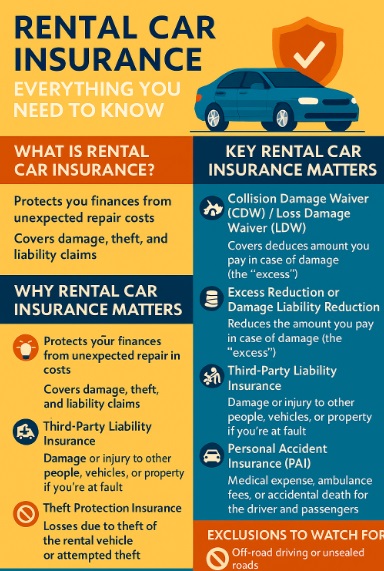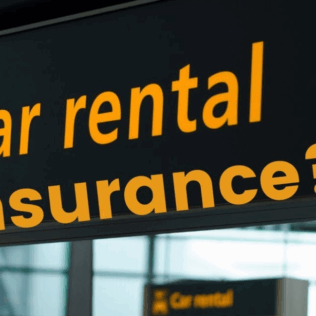Renting a car comes with freedom, convenience, and flexibility—especially when exploring new destinations. However, one crucial element that often confuses renters is rental car insurance. Understanding your insurance options ensures you’re protected in case of an accident, damage, or theft, and it can also help you avoid unexpected costs.
In this comprehensive guide, we’ll break down everything you need to know about rental car insurance, including what’s included by default, the different types of coverage available, when you need additional insurance, and how to make the right choice for your trip.

What Is Rental Car Insurance?
Rental car insurance protects you financially if something happens to the vehicle while it’s in your possession. This could include collision damage, theft, injury to others, or liability claims. Depending on where you’re renting and the provider, some insurance might be included by default, while others are offered as optional extras.
In Australia, for example, most rental companies include basic insurance with an excess (the amount you’re responsible for if something goes wrong). But you can upgrade coverage or purchase excess reduction to minimise your liability.
Why Rental Car Insurance Matters
Imagine driving a rental car and accidentally scratching it in a car park. Without the right insurance, you could be liable for thousands of dollars—even if the damage seems minor. Rental car insurance:
- Protects your finances from unexpected repair costs
- Covers damage, theft, and liability claims
- Offers peace of mind while you travel
- Helps you avoid disputes or confusion with rental companies
- May include roadside assistance and other perks
Understanding your options ensures you only pay for the coverage you truly need—and nothing you don’t.
Key Types of Rental Car Insurance
There are several main types of coverage you’ll encounter when hiring a car. These vary by provider and country but generally include the following:
1. Collision Damage Waiver (CDW) / Loss Damage Waiver (LDW)
- What it covers: Damage to the rental vehicle in an accident, theft, or vandalism.
- What it doesn’t cover: Tyres, windscreens, underbody, or roof (unless specifically included).
- Is it required? Often included with an excess. You can usually pay extra to reduce or eliminate the excess.
2. Excess Reduction or Damage Liability Reduction
- What it covers: Reduces the amount you pay in case of damage (the “excess”).
- Example: Instead of paying $4,000 in repairs, you might pay only $300 with excess reduction.
- When to get it: If you want peace of mind or are travelling in busy cities or rough terrains.
3. Third-Party Liability Insurance
- What it covers: Damage or injury to other people, vehicles, or property if you’re at fault.
- Is it included? In Australia, this is generally included due to legal requirements.
- Good to know: Always double-check that the rental company provides a suitable level of third-party cover.
4. Personal Accident Insurance (PAI)
- What it covers: Medical expenses, ambulance fees, or accidental death for the driver and passengers.
- Is it necessary? Often redundant if you already have travel insurance or health coverage.
5. Theft Protection Insurance
- What it covers: Losses due to theft of the rental vehicle or attempted theft.
- Is it included? Usually bundled with CDW/LDW.
- Tip: Always lock the car and keep valuables hidden to avoid disputes.
Should You Use Your Own Insurance?
Some travellers might be covered by their existing travel insurance, credit card benefits, or personal car insurance policies. However, it’s important to confirm:
- What’s covered and excluded
- Whether the policy covers international rentals
- If excess or liability is included
- If you need to decline the rental company’s insurance to use your own
For example, many credit cards offer rental insurance, but only if you pay for the booking using that card—and they might exclude certain vehicles or countries.
Exclusions to Watch For
Even with rental insurance, there are situations where your claim could be denied. Be aware of these common exclusions:
- Off-road driving or unsealed roads
- Unauthorised drivers not listed on the agreement
- Driving under the influence of alcohol or drugs
- Leaving keys in the vehicle
- Breach of rental terms and conditions
- Driving outside permitted areas (e.g., interstate or restricted zones)
Always read the fine print and clarify any questions with the rental company before signing.
Rental Car Insurance in Australia: What You Need to Know
If you’re renting a car in Australia, here’s how coverage usually works:
- Standard rental includes basic liability and collision cover with a high excess (commonly $3,000–$5,000).
- You can purchase excess reduction or premium protection for added peace of mind.
- Many Australian car rental companies offer optional extras like windscreen and tyre protection.
Tip: If you’re planning to travel through outback regions or long-distance drives, enhanced protection is strongly recommended.
Third-Party Insurance Alternatives
If you don’t want to pay high daily rates from the rental company, consider buying standalone rental car insurance from third-party providers. These are often:
- Cheaper than in-house options
- Offer lower excess rates
- May include coverage for extras like lost keys, admin fees, and towing
Be sure to confirm that the rental company will accept third-party coverage, and that your policy meets all requirements.
How to Choose the Right Coverage
Choosing the best rental insurance depends on several factors:
Ask Yourself:
- How much is the excess and what’s my risk tolerance?
- Does my credit card or travel insurance already provide coverage?
- Am I driving in high-risk areas, off-road, or overnight?
- Do I want a hassle-free experience in case of damage or theft?
If you’re risk-averse or unfamiliar with local driving laws, consider purchasing full coverage or excess reduction for peace of mind.
Tips to Save on Rental Car Insurance
Here’s how to avoid overpaying while still getting the coverage you need:
- Compare insurance options online before you book
- Decline overlapping coverage if your travel insurance already covers rental cars
- Book through rental companies that offer transparent pricing
- Join loyalty programs for potential insurance discounts
- Use credit cards that include rental car protection as part of their perks
Common FAQs About Rental Car Insurance
1. Is rental car insurance mandatory?
While not legally required in some countries, rental companies often include basic cover with high excess and require you to be financially liable unless you reduce it.
2. What happens if I damage the rental without insurance?
You could be liable for all repair costs, often up to several thousand dollars, depending on the rental agreement.
3. Can I add another driver to the insurance?
Yes, but they must be listed on the rental contract. Additional fees may apply.
4. Does rental insurance cover flat tyres or windscreens?
Not always. You may need to purchase an extra “tyre and windscreen” waiver.
5. What should I do if the rental car is damaged or stolen?
Contact the rental company immediately, file a police report if required, and follow their claims process. Take photos and keep all documents.
Conclusion: Drive Confidently with the Right Cover
Understanding your rental car insurance options empowers you to make informed decisions and avoid nasty surprises. From collision waivers to excess reduction, the right protection will give you peace of mind—whether you’re navigating city streets or taking on scenic coastal drives.
Before you book, review what’s included, assess your personal insurance coverage, and choose the level of protection that suits your travel style and budget.
Need a Reliable Rental with Flexible Insurance Options?
At Trend Rentals, we offer transparent, affordable rental car insurance options across our entire fleet. Whether you’re hiring a 12-seater van, 4WD ute, or minibus, we help you hit the road with confidence.
Explore our range of vehicles and book online today.
